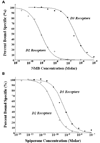Decreased striatal dopamine receptor binding in primary focal dystonia: a D2 or D3 defect?
- PMID: 20960437
- PMCID: PMC3025272
- DOI: 10.1002/mds.23401
Decreased striatal dopamine receptor binding in primary focal dystonia: a D2 or D3 defect?
Abstract
Dystonia is an involuntary movement disorder characterized by repetitive patterned or sustained muscle contractions causing twisting or abnormal postures. Several lines of evidence suggest that abnormalities of dopaminergic pathways contribute to the pathophysiology of dystonia. In particular, dysfunction of D2-like receptors that mediate function of the indirect pathway in the basal ganglia may play a key role. We have demonstrated with positron emission tomography that patients with primary focal cranial or hand dystonia have reduced putamenal specific binding of [(18)F]spiperone, a nonselective D2-like radioligand with nearly equal affinity for serotonergic 5-HT(2A) sites. We then repeated the study with [(18)F]N-methyl-benperidol (NMB), a more selective D2-like receptor radioligand with minimal affinity for 5-HT(2A). Surprisingly, there was no decrease in NMB binding in the putamen of subjects with dystonia. Our findings excluded reductions of putamenal uptake greater than 20% with 95% confidence intervals. The analysis of the in vitro selectivity of NMB and spiperone demonstrated that NMB was highly selective for D2 receptors relative to D3 receptors (200-fold difference in affinity), whereas spiperone has similar affinity for all three of the D2-like receptor subtypes. These findings when coupled with other literature suggest that a defect in D3, rather than D2, receptor expression may be associated with primary focal dystonia.
Copyright © 2010 Movement Disorder Society.
Conflict of interest statement
Figures

References
-
- Fahn S, Bressman SB, Marsden CD. Classification of dystonia. Adv Neurol. 1998;78:1–10. - PubMed
-
- Wooten GF, Trugman JM. The dopamine motor system. Mov Disord. 1989;4 Suppl. 1:S38–S47. - PubMed
-
- Schneider SA, Bhatia KP, Hardy J. Complicated recessive dystonia parkinsonism syndromes. Mov Disord. 2009;24(4):490–499. - PubMed
-
- Poewe WH, Lees AJ, Stern GM. Dystonia in Parkinson's disease: clinical and pharmacological features. Ann Neurol. 1988;23(1):73–78. - PubMed
-
- Nygaard TG. Dopa-responsive dystonia. Curr Opin Neurol. 1995;8(4):310–313. - PubMed
Publication types
MeSH terms
Substances
Grants and funding
- P30 NS057105/NS/NINDS NIH HHS/United States
- NS031001/NS/NINDS NIH HHS/United States
- NS058714/NS/NINDS NIH HHS/United States
- NS041509/NS/NINDS NIH HHS/United States
- P30NS05710/NS/NINDS NIH HHS/United States
- R01 NS041509/NS/NINDS NIH HHS/United States
- R01 ES013743/ES/NIEHS NIH HHS/United States
- R01 NS050425/NS/NINDS NIH HHS/United States
- NS050425/NS/NINDS NIH HHS/United States
- R01 NS039821/NS/NINDS NIH HHS/United States
- U54 NS065701/NS/NINDS NIH HHS/United States
- R01 NS031001/NS/NINDS NIH HHS/United States
- R01 DA024675/DA/NIDA NIH HHS/United States
- R 21 NS050658-01A1/NS/NINDS NIH HHS/United States
- R01 NS058714/NS/NINDS NIH HHS/United States
- UL1 RR024992/RR/NCRR NIH HHS/United States
- R01 NS058797/NS/NINDS NIH HHS/United States
LinkOut - more resources
Full Text Sources

